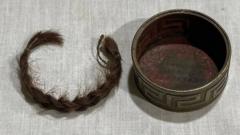Will You Bid on Lord Admiral Nelson's Hair Plait at Auction?

A Fascinating Piece of History: The Lock of Hair from Lord Admiral Horatio Nelson
In a captivating twist of fate, a lock of hair belonging to Lord Admiral Horatio Nelson, a revered figure in naval history, is about to go under the hammer. Discovered in an unlikely location—a recycling skip—over 40 years ago, this unique relic is expected to fetch a substantial sum at auction. With a rich history and a compelling backstory, this lock of hair is more than just a physical object; it represents a connection to a pivotal moment in British history.
The Legacy of Lord Admiral Horatio Nelson
Born in 1758 in Burnham Thorpe, Norfolk, Horatio Nelson rose from humble beginnings to become one of Britain's most celebrated naval commanders. Joining the navy at just 12 years old, Nelson quickly established himself as a formidable leader, known for his tactical brilliance and fearless nature. His most famous victory came during the Battle of Trafalgar in 1805, where he led the British fleet against a combined French and Spanish fleet, ultimately securing British naval supremacy.
Nelson's legacy extends beyond his military achievements; he is also remembered for his personal sacrifices, including his tragic death during the Battle of Trafalgar. Struck down by a French sniper, Nelson's passing marked the end of an era, but his memory lived on, cementing his status as a national hero. Today, artifacts related to his life and career are highly sought after, and the lock of hair is no exception.
The Discovery of the Lock of Hair
The lock of hair was found in the 1980s by a local individual while working at a recycling skip. This serendipitous discovery has captured the attention of historians and collectors alike. Accompanied by a handwritten letter from a professor dated 1911, which verifies its authenticity as a "genuine relic," this piece of history is now set to attract serious bids at auction. Simon Bower, an auctioneer at Morgan Evans and Co., describes the lock as an "amazing find" and a "definite rarity."
According to Bower, the man who discovered the hair has kept it in his possession since the 1980s, when salvaging from skips was common practice. He noted that the contemporary approach to skip diving requires permission, making this discovery all the more remarkable. The lock of hair, which is plaited, is expected to sell for between £400 and £500, although its value could potentially increase depending on the interest it garners from collectors and museums.
The Relevance of Historical Artifacts
The fascination with historical artifacts like the lock of Nelson's hair speaks to a broader interest in preserving and understanding our past. Items that once belonged to notable figures offer invaluable insights into their lives and the times they lived in. Collectors and historians often seek such relics to help tell the stories of these individuals and the impact they had on society.
- Educational Value: Historical artifacts serve as tangible connections to the past, providing opportunities for learning and exploration.
- Cultural Significance: They often highlight important cultural and societal shifts, making them essential for understanding history.
- Investment Potential: As seen in the case of Nelson's hair, historical items can appreciate over time, making them appealing to collectors.
The Auction Process and Market for Historical Relics
The auctioning of such unique items opens up a fascinating dialogue about the value of history and how it is perceived in contemporary society. Bower mentions that the range of prices for historical relics can vary significantly, from hundreds to thousands of pounds, depending largely on the item's background and provenance. As the auction approaches, the anticipation builds around whether this lock of hair will find its way into a museum for public appreciation or a private collection where it may be less accessible.
The auction process itself involves assessing the item's value, marketing it to potential buyers, and ultimately facilitating the sale. Auction houses typically conduct extensive research to authenticate and appraise items, ensuring that they can provide accurate information to bidders. This meticulous process not only legitimizes the item but also enhances its marketability.
Preserving History: Museums vs. Private Collections
The debate over whether historical artifacts should be housed in museums or private collections is ongoing. Museums play a crucial role in preserving history and making it accessible to the public. They provide educational programming and exhibitions that allow people to engage with the past in meaningful ways. On the other hand, private collectors often invest significant resources into maintaining and caring for these artifacts, sometimes dedicating personal spaces to showcase their collections.
Ultimately, the ideal scenario is one where historical items are preserved and appreciated, regardless of their location. The lock of hair from Horatio Nelson serves as a reminder of the importance of preserving our heritage and the stories behind the artifacts that shape our understanding of history.
What Makes This Lock of Hair Special?
Several factors contribute to the significance of this lock of hair beyond its mere existence. First and foremost is its association with Lord Admiral Horatio Nelson, a key figure in British naval history. The lock serves as a personal connection to a man revered for his courage and strategic mind. The authentication from the 1911 letter adds an extra layer of credibility, increasing its desirability among collectors.
Additionally, the circumstances of its discovery make it a unique story. The fact that it was found in a recycling skip points to the serendipitous nature of history—how some items can slip through the cracks and yet emerge as valuable pieces of our past. This adds an element of intrigue and romance to the item, further enhancing its appeal.
Conclusion: A Reflection on History and Its Legacy
The upcoming auction of Lord Admiral Horatio Nelson's lock of hair highlights the enduring fascination with historical figures and their artifacts. The story of its discovery, combined with its historical significance, makes this relic a valuable piece of British heritage. As the auction date draws near, collectors and history enthusiasts alike are left to wonder about the future of this unique item—will it be a cornerstone of a museum exhibit or a cherished part of a private collection?
As we reflect on the importance of preserving history, we are reminded that every artifact tells a story. Whether through public displays or private ownership, these items serve to connect us with our past and inspire future generations. What are your thoughts on the balance between public and private ownership of historical artifacts? Can you think of other significant relics that deserve to be preserved for posterity? #History #Nelson #Auction
FAQs
What is the significance of the lock of hair from Lord Nelson?
The lock of hair is significant as it is a physical connection to Lord Admiral Horatio Nelson, a key figure in British naval history, known for his victories during the Napoleonic Wars.
How was the lock of hair discovered?
The lock was discovered in the 1980s by a man working at a recycling skip, where he salvaged it along with a verification letter from a professor.
What is the estimated auction price for the lock of hair?
The lock of hair is expected to sell for between £400 and £500, though its ultimate value will depend on demand at the auction.
Will the lock of hair be displayed in a museum or kept in a private collection?
It remains uncertain whether the lock will be purchased by a museum for public display or acquired by a private collector.
Why are historical artifacts important?
Historical artifacts provide tangible connections to the past, allowing us to learn about and engage with history, while also holding cultural significance and investment potential.
Published: 2025-07-31 10:55:16 | Category: wales



